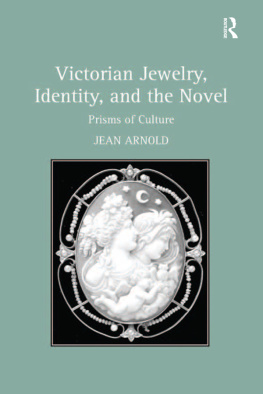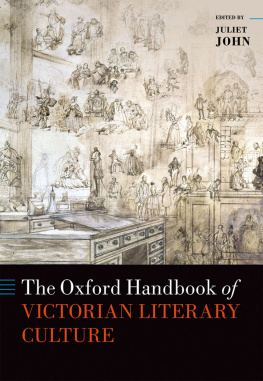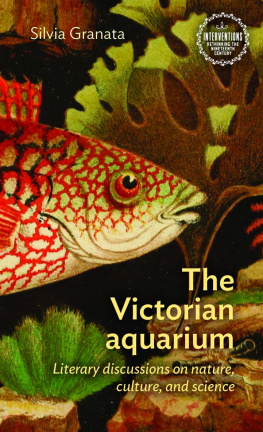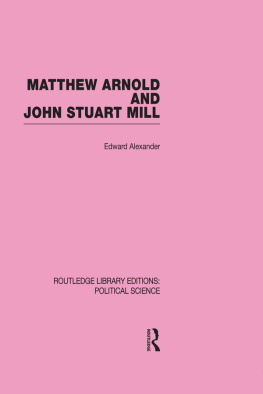VICTORIAN JEWELRY, IDENTITY, AND THE NOVEL
for Tony
Victorian Jewelry, Identity, and the Novel
Prisms of Culture
JEAN ARNOLD
California State University, San Bernardino, California
Frist published 2011 by Ashgate Publishing
Published 2016 by Routledge
2 Park Square, Milton Park, Abingdon, Oxon OX14 4RN
711 Third Avenue, New York, NY 10017, USA
Routledge is an imprint of the Taylor & Francis Group, an informa business
Copyright Jean Arnold
Jean Arnold has asserted her right under the Copyright, Designs and Patents Act, 1988, to be identified as the author of this work.
All rights reserved. No part of this book may be reprinted or reproduced or utilised in any form or by any electronic, mechanical, or other means, now known or hereafter invented, including photocopying and recording, or in any information storage or retri eval system, without permission in writing from the publishers.
Notice:
Product or corporate names may be trademarks or registered trademarks, and are used only for identification and explanation without intent to infringe.
British Library Cataloguing in Publication Data
Arnold, Jean.
Victorian jewelry, identity, and the novel : prisms of culture.
1. Diamonds--Social aspects. 2. Social values--History-
19th century. 3. Collins, Wilkie, 18241889. Moonstone.
4. Eliot, George, 1819-1880. Middlemarch. 5. Thackeray,
William Makepeace, 18111863. Great Hoggarty diamond.
6. Trollope, Anthony, 18151882. Eustace diamonds.
7. Jewelry in literature.
I. Title
823.809353-dc22
Library of Congress Cataloging-in-Publication Data
Arnold, Jean, 1939
Victorian jewelry, identity, and the novel : prisms of culture / Jean Arnold.
p. cm.
Includes bibliographical references and index.
ISBN 978-1-4094-2127-6 (hbk)
(ebk.) 1. English fiction--19th century--History and criticism. 2. Material culture in literature. 3. Gems in literature. 4. Jewelry in literature. 5. Object (Aesthetics) in literature. 6. Identity (Psychology) in literature. 7. Gems--Symbolic aspects. 8. Values in literature. 9. Values--Great Britain--History--19th century. 10. Material culture--Great Britain--History--19th century. I. Title.
PR878.M38A75 2011
823.8093564--dc22
2010052523
ISBN 9781409421276 (hbk)
Contents
Deep thanks go to all those who have contributed to this volume. A form of has appeared in Victorian Literature and Culture, Volume 30, Number 1, 2002, and I am grateful to Adrienne Munich and John Maynard, editors, and to Richard Stein, reader, for their interest and suggestions in bringing this chapter to print. I thank the editors for their permission to reprint the material here.
The book has evolved in response to written resources in the field of literary criticism, cultural criticism, theory, anthropology, economics, sociology, and philosophy, and so it is to some extent a product of its times. At the same time the work has developed organically as writers, readers, and friends have contributed ideas and references. The book is therefore offered as a gift to all those who have read and responded to various drafts; their encouragement, belief, and insights have been an integral part of its growth. John Briggs, Jean Gillingwators, Jennifer Manion, and Jnan Sellery have all responded thoughtfully to the working manuscript. Special thanks also go to Wendy Belcher and Margaret Waller for their friendship and suggestions over several years. Writers Group colleagues at California State University, San Bernardino, offered their insights and suggestions to various drafts, vital contributions that mean more me to than I am able to express. Luz Elena Ramirez, our groups driving force and organizer, Jenny Andersen, Anne Bennett, and Nancy Best will see their superlative ideas and suggestions on many of these pages.
Members of Victoria Listserv have been supportive and interested, engaging in lively conversation about Victorian jewelry, available in the lists archives at http:listserv.indiana.edu/archives/victoria.html. With over 50 entries on the search topic Victorian Jewelry, this inspiring and authoritative source was constructed from the listservs community of experts. One list member wrote that, after his students had joined the online discussion and then completed a survey, Victorian Jewelry turned out to be their favorite topic. Here my thanks go to Patrick Leary, list moderator, who for many years has guided the list with a firm, diplomatic hand as he has developed it into a professional model of its kind.
I thank colleagues in NAVSA, VISAWUS, and PAMLA who have given feedback and suggestions for new sources in response to my oral presentations. California State University, San Bernardino, has supported my research, and my special thanks go to Rong Chen, former department chair, whose generous support helped this project along at a crucial juncture.
I also give thanks to longtime friends in The Shakespeare Club who have provided positive interest during the course of this project. To Anita Arnold, I give credit for her specialized consultation and expert work on some of the images appearing in the book, and to Mary Anntiques.com for sharing their fabulous collection of cameos and miniatures. To my whole family, I give my thankful appreciation for always being there, and to Tony, I give profound thanks for his singular support; his presence and encouragement made the book possible.
My deep thanks go to Ann Donahue, editor extraordinaire, and the anonymous reader at Ashgate for many formative ideas in building the final version of this work. Marc Redfield has given me inspiration and excellent advice over a number of years, so that his diffused influence fills many of these pages.
To all these people, then, I offer the gift of this book, in reciprocation for their many gifts of support in the form of friendship and critical input. The book belongs to you all, and my appreciation goes beyond words or any means of representation, as it stretches across global distances and passing years.
Chapter 1
Introduction: Jewels and the Formation of Identity in Victorian Literature and Culture
In Charles Dickenss Little Dorrit, Mrs. Merdles jewels enable her to represent and express Society so well (I.33). What sustains this portrayal of Mrs. Merdle is her husbands exalted position within a materialist culture based on free-wheeling capitalism. Mr. Merdle is variously hailed the mastermind of the age, an illustrious man and great national ornament, Gigantic Enterprise, The Wealth of England, Credit, Capital, and Prosperity: in short, the very personification of prodigious capital accumulation (II.24). In the London high society depicted in the novel, Mrs. Merdles role as wife of the prestigious and wealthy Mr. Merdle is to display her valuable jewels as class markers. With revealing, typical hyperbole, Dickens informs his readers that Mrs. Merdle possesses a capital bosom to hang jewels upon, so that the Bosom moving in Society with the jewels displayed upon it, attracts general admiration (I.21).
As Dickens portrays the power of a womans bejeweled image to signify class rank in the socioeconomic hierarchy, his commentary on jewels also marks the Merdless narrowly rigid gender roles in their marriage as situated within a capitalist value system: Mr. Merdle wanted something to hang jewels upon, and he bought it for that purpose (I.21). As gender roles developed in response to industrial capitalism of the Victorian age, men had renounced the wearing of conspicuous jewels; by contrast, women continued and developed the practice. Writers on fashion and clothing of the period alternatively note that the early British nineteenth century featured a great masculine renunciation or fashions new gender disjunction, in which men wore business suits, while women wore colorful jewels and changing fashions.








